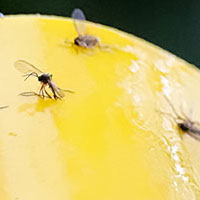Gnat facts and info

Gnats are small flying insects — you probably know them as a tiny nuisance. If you’re experiencing an infestation of small pests, especially in your kitchen, you might be dealing with gnats. It’s important to know the signs of an infestation and how to eliminate any attractions so you can prevent future infestations.
Key insights
- While gnats aren’t a real threat to humans, they are annoying, and their presence can be a sign of cleanliness issues in your home.
- Gnats are small, so they’re easy to confuse with other tiny pests like fruit flies. Both species are quick to multiply, but they’re also quick to die.
- Keep your home and garden free of excessive moisture, decomposing organic matter and too-ripe fruits and vegetables to keep gnat populations at bay.
What do gnats look like?
Gnats are small, flying insects that range in size from one-sixteenth to one-eighth of an inch long. They have slender, elongated bodies and are usually black, brown or gray.
Gnats have two see-through wings that are proportionally larger than their body size, making them agile fliers. They also have big, compound eyes, a wide field of vision and long, thin antennae for detecting smells and vibrations.
Gnat vs. fruit fly
Gnats and fruit flies can seem similar at first glance, but they have a few distinguishing characteristics and habits:
- Physical differences: Fruit flies are generally larger than gnats, ranging from one-eighth to three-sixteenths of an inch in length. They’re also typically tan or brown; gnats are usually darker. Fruit flies have distinctive red eyes, which sets them apart from most gnats.
- Habits: Gnats are attracted to moisture and decaying organic matter, while fruit flies prefer ripening and fermenting fruits and vegetables.
What attracts gnats?
Gnats are drawn to homes for several reasons, but they tend to hang out in kitchens and gardens. The insects are attracted to decomposing plant material, food waste and even damp soil in potted plants. Overripe or rotting fruits and vegetables can also attract gnats.
Keep in mind that standing water, leaky pipes and damp areas are ideal breeding grounds for gnats. To deter gnats from invading your home, you should maintain a clean living space, dispose of food waste properly and address any moisture-related issues.
Signs of a gnat infestation
While gnats aren’t dangerous, they definitely can be annoying — and they multiply rapidly. Common signs of a gnat infestation include:
- Presence of adult gnats: You may notice gnats flying around in small groups or resting on surfaces near their breeding grounds.
- Larvae: Gnat larvae are small, wormlike creatures that can be found in moist areas, such as the soil of potted plants or near drains.
- Eggs: Gnat eggs are tiny and difficult to see, but you might see large clusters of eggs near breeding sites.
To identify a gnat infestation, inspect areas with decaying organic matter and standing water. Check your kitchen counters or hanging baskets for overripe (usually soft, squishy and fragrant) fruits and vegetables.
How to get rid of gnats
There are several methods for eliminating gnats if they’ve taken over your home:
- Physical control: Use sticky traps, fly swatters or a vacuum cleaner to remove adult gnats.
- Chemical control: Apply insecticides or larvicides according to the manufacturer's instructions to target gnat larvae and adults.
- Preventive measures: Maintain proper sanitation practices by keeping your home clean, disposing of food waste promptly and addressing moisture issues. Regularly inspect potted plants and remove any standing water to eliminate potential breeding grounds.
It might take just one of these methods — or a combination — but you can effectively control and prevent gnat infestations in your home with a reasonable amount of effort.
FAQ
What do gnat eggs look like?
Gnat eggs are tiny, oval-shaped and often white or transparent in color. Due to their minuscule size, gnat eggs can be challenging to spot with the naked eye. They’re typically laid in clusters near breeding sites like damp soil, decaying organic matter and areas with excess moisture.
When is gnat season over?
Gnat season varies based on the region and climate. In general, gnats are most active during the warmer months, from late spring to early fall. In warmer climates, though, they may be active year-round. Gnat populations tend to decline as temperatures drop and weather conditions become less favorable for breeding and survival.
How did I get gnats?
Gnats are attracted to decaying plant matter, moisture and overripe or rotting fruits and vegetables. If you have damp areas, standing water or decomposing organic material in your home, these might have attracted the gnats. They can enter your house through open windows, doors or other gaps in your home's exterior.
How serious is a gnat infestation?
While a gnat infestation can be annoying and bothersome, it’s not considered a real threat to human health.
Some species of gnats, such as fungus gnats, can damage plants by feeding on their roots, which may lead to stunted growth or even plant death. A gnat infestation can also be a sign of sanitation issues, given gnats’ attraction to decaying organic matter and moisture. Addressing the infestation and eliminating attractants can help maintain a cleaner and more pest-free living environment.
You’re signed up
We’ll start sending you the news you need delivered straight to you. We value your privacy. Unsubscribe easily.